The Gift of South Dakota
Subscriptions to South Dakota Magazine make great gifts!
Subscribe today — 1 year (6 issues) is just $29!
Bird Signs at Bear Butte
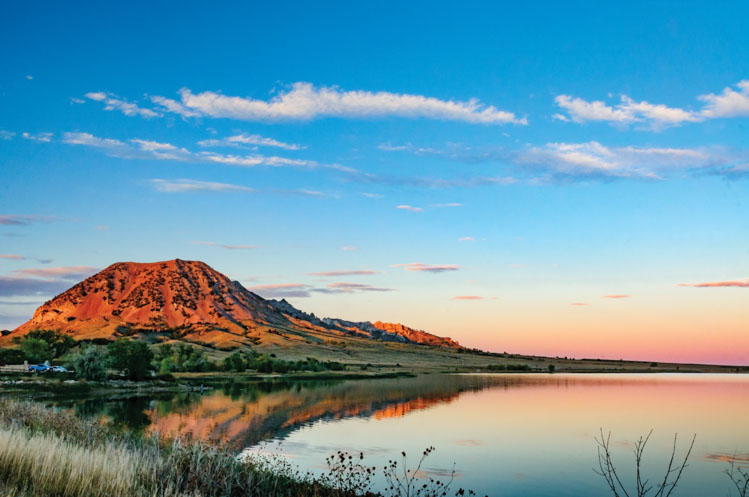 |
| Bear Butte, an ancient volcano in Meade County, is a sacred place for Native tribes. |
GRANDMA USED TO SAY that her father shouldn’t have been a farmer, though he made do. Besides wearing overalls, the man liked to dance and take photographs and had a deep, bellowing laugh. During the summer, he’d come in for lunch, turn on the radio and lay down on the cool kitchen floor, listening to voices discuss grain prices. His wife did all the farm thinking, bought livestock and paid the bills. That was before they had children, and then she delegated most of the management to her two oldest sons while the younger sisters drove the grain truck with their father.
My grandmother was born in Gary in 1927. Back then, people not only watched, but looked for birds — and believed in them — as signals. Cardinals came in spring, an owl was a ghost, a red-tailed hawk was good luck (three of them worth a harvest) and an eagle was a sign of greatness.
Each Sunday, our family would visit Grammy in the nursing home, and she’d tell stories; how her mother had premonitions, signs of things to come, like when a glass was broken in the kitchen on the same afternoon an ornery hog trampled a farmhand and bit off the tip of his thumb. As she spoke, she would turn her attention to each audience member and then let her eyes drift off to the horizon.
Four months before she passed away in October 2021, Grammy took a road trip to Bear Butte, a place she had always wanted to visit. She saw the buffalo pasture, fell asleep at the lake and stayed at the Hotel Sturgis, closer to Rapid City for an evening dinner with her sister. It was left unsaid that it would probably be her last trip back to South Dakota. To give Mom, Grammy and her sister some time alone, I decided to hike Bear Butte.
*****
NORTHEAST OF THE STURGIS “Hollywood” sign, the hillside rises into a thicket of pine trees, a brief territory that expands roughly 2,000 feet and encompasses prime land for cabin plots. From a bird’s eye view, ripples of igneous rock run parallel to Highway 34, eventually disappearing into a plain of county highway, foothills and hay country. The air is clear, and you can smell the sweet oil from miles of prairie grass that can grow as high as a buffalo, pitched with a wind that makes the fields appear to roll like the Atlantic Ocean. From a distance, the saddle of an isolated hill forms two small, furry bumps, the shoulders and rear haunches of something gargantuan. It looks as if some beast might be sleeping on the wide prairie.
As you approach on a wide-bending county road, signs mark the beginning of Bear Butte National Wildlife Refuge. The lake appears on your left with a burgundy sign for the Centennial Trail head and then another sign showing you through the buffalo pasture at the base of the butte.
Bear Butte is Mato Paha to the Lakota Nation, or Bear Mountain. People don’t agree on whether the geographer’s standard appropriately rules-in the formation as a butte or just a lonesome hill, deep with rocky crags.
For hundreds of years, the mountain has been an active ceremonial site, with indigenous tribes utilizing it for a variety of spiritual experiences. The mountain has also served as a destination waypoint for travelers across the Great Plains long before the creation of an iPhone, Wi-Fi or Google Maps. As the ancient volcano rises 900 feet abruptly into the sky, the rocky laccolith is considered a bridge from this world to the next, a place to communicate with, interpret, signal and understand a world beyond the physical one we experience.
I started early, just as the middle of night began to shrug off. At sunrise, I watched light pour into the creek valley. The reflection looked like a golden Colossus, a giant with arms reaching toward the sky. With each step up the trail, light expanded across the horizon, warming the back of my ears. Immersed in the cozy scent of pine, I felt a force, a great spirit, as if it might lift me off the Earth.
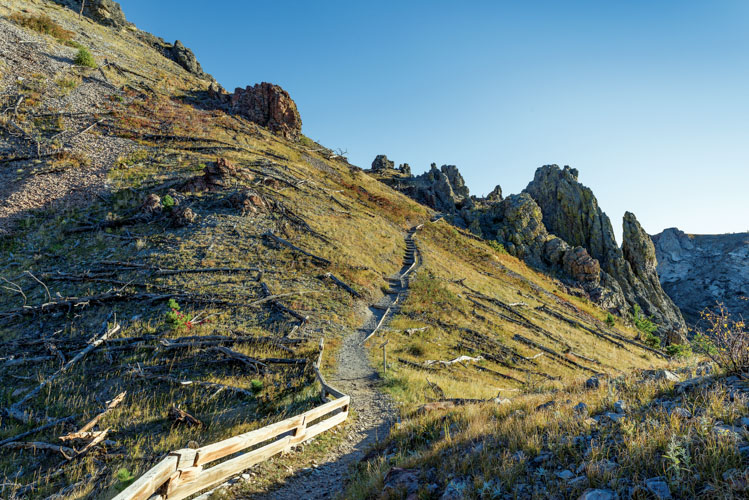 |
| Thousands of people ascend Bear Butte every year, some seeking spiritual clarity. |
From the lodge at the base of the mountain, the trail furrowed through the forest. I saw trees filled with sacred offerings: articles of cloth tied into pouches with tobacco, peppermint and other prairie herbs, each offering knotted around branches of cedar and pine. The cloths flapped in the quickening wind, the number of offerings so great that the bundles looked like people in a caravan toward the top. The scene reminded me that I wasn’t alone.
Approaching the trailhead, I saw two mule deer and they saw me. They turned to stone, the white button of each tail tufted into the dark air, their ears turned flat in my direction. Stepping forward, my heel crunched the gravel. They moved 10 or 15 feet and then looked back again with the same curiosity. They moved off further. I moved and they moved, turning to look back one last time before pelting off down the slope of the mountain.
Closer to the summit, I saw a shirtless man meditating off the trail on the eastern face of the rock, the boundless wind lifting his long, braided ponytail into the sky. He seemed to be inviting the sun onto the mountain. He must have started his journey earlier than me — or he was there all night. He gently tied a knotted piece of cloth to the outer branch of a young pine, careful not to cause a change in the growth of the stripling. The article is offered to the elements: the Great Sky, the Sun, the Earth, eternally blessed by the spirit of the morning light.
The man stopped at each promontory on his travel down the mountain. As the switchbacks slither up and down through the jagged slopes, these portions triangulate, leveling off to cradle valuable lookout points where the soil is amenable enough for yucca to grow.
At each nest of rocks, the man paused. He cupped his hands to his mouth, but there was no noise at first. Then I heard a flickering whistle.
Weet, weet, weet.
The warble of a bird, as if a meadowlark shadowed him up the mountain. He continued this ritual until I could no longer see him in the folds at the base valley. I descended the trail feeling better than when I began, my mind quiet and more connected, thinking of ways to take this sacred mountain with me wherever I go.
*****
AFTER MY GRANDMOTHER’S death, I returned to Bear Butte in January wanting to reconnect, looking for a sign. I thought of my grandparents, and how they made their home into ours when we moved to Nebraska from the East Coast. How they sheltered us from the storms in life. How they showed us good and believed in enduring altruism. I carried these spirits as well as a promise to look for something great, like an eagle. Incredibly, I saw one as I left Lincoln, Nebraska, for the Sandhills. It was a good sign and a rare sight for the capital city. I knew it would be a wonderful trip.
From the Sandhills I traveled through Pine Ridge, Rapid City and then Sturgis, arriving just as the sun pushed the horizon. The blue daylight turned an orange cream, like the inside of a Cadbury egg. The stores in town still slept, and there was no place to eat besides the gas station. I filled up on coffee and bottled water before heading out to Highway 34.
The temperature started in the teens. The wind was festive, always present and nipping before the 900-foot ascension. Sunrise on January 16 was at 7:26 a.m. I plowed into the mountain, feeling the furnace on the horizon beginning to brighten.
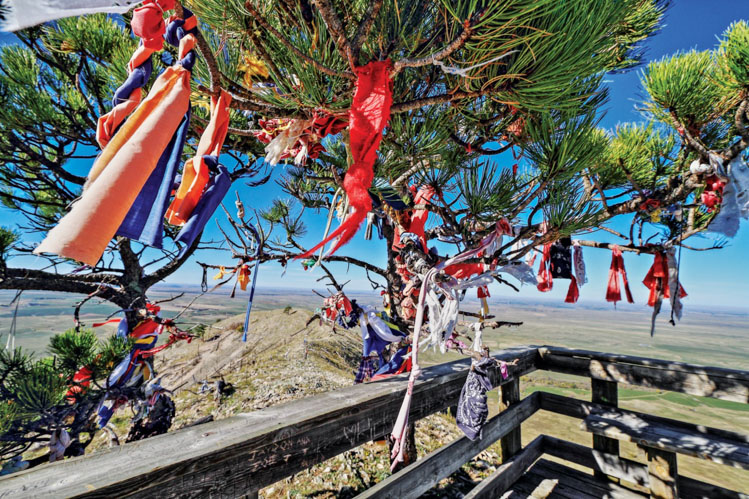 |
| Prayer cloths and bundles, found along the trail to Bear Butte's summit, are left as offerings to higher spirits. |
Halfway up I saw a couple farther along the trail, perched on the slope 75 feet above. The wind unexpectedly rushed, brushing off my stocking cap and making me teary-eyed. Heavy clouds in the distance indicated that a weather system was sprinting towards the butte. The couple appeared, then disappeared before emerging again on the trail before me. The man carried a plastic bag and a bone-pipe flute. I suddenly realized they wore blue jeans, sneakers, stocking caps and thin cotton gloves, the kind you’d use to detassel corn. I felt empathetically cold, dressed in coveralls, hiking boots and insulated gloves.
It began to snow. With this wind, the flakes bit at my cheeks, sharper than glass.
“Did the weather scare you off?” the woman asked as she pulled the hood of her windbreaker around her chin.
“Something like that,” I replied.
The man told me that they had to reach the top of Bear Butte for their ceremony; a sacred rite, part of which requires summiting the mountain under any circumstances and depositing their offerings at the top. The objects to be offered were in the plastic bag — an umbilical cord and placenta. These pieces were bound in clothing and tied into the trees. Some were placed underneath the yucca. He described it as a blessing. For their children. For better education, opportunities, wealth and beyond that — a home. So that no matter what happens, they will never be lost, they will always have a home, a place they can always return to on Bear Butte.
We exchanged a warm wave and they departed.
“Have a good day,” the man said.
“Safe travels,” I replied.
I watched them travel down the mountain, stopping at the next promontory 50 feet below. He held the flute to his lips. I could hear it, the notes sounding tiny in the wind, the high-pitched air fluttering through the bone tube towards the sun. The warble of a meadowlark. To the west the sky was dark, hiding a range of rock behind low clouds southwest of the mountain. In the east, the glowing sun peacefully climbed.
That’s when I saw two mule deer, perhaps the same pair that I met during the summer. They stared like they knew me, perhaps carrying the spirits of what was. I thought of the eagle, and my promise to look for something great, and I was reminded here on Bear Butte, no one is lost. Wherever life takes us, there is always a place, if only sometimes a feeling, that we can call home.
I listen.
Weet, weet, weet.
I thought of my grandparents, loved ones, lost or not, imagining them as part of the caravan of colored cloth traveling through trees.
Alex Zappala is a writer and musician living in Lincoln, Nebraska.
Editor’s Note: This story is revised from the July/August 2022 issue of South Dakota Magazine. To order a copy or to subscribe, call (800) 456-5117.


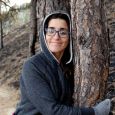
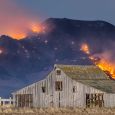

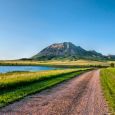
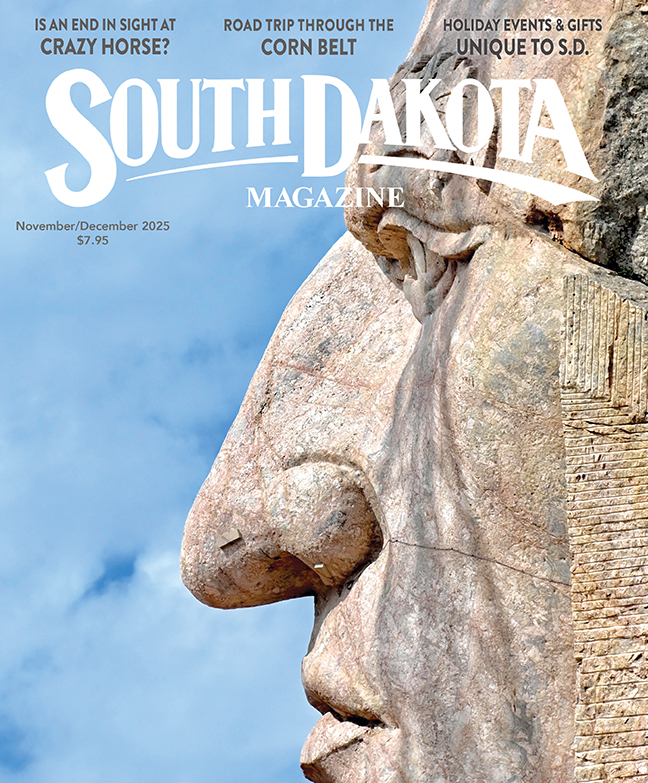

Comments